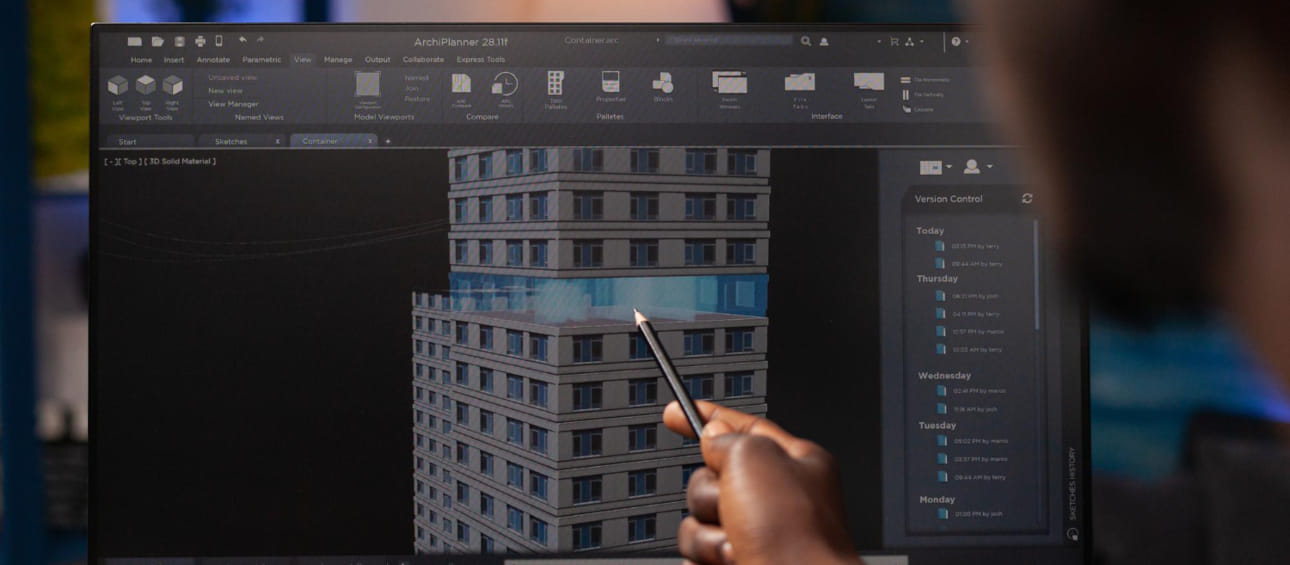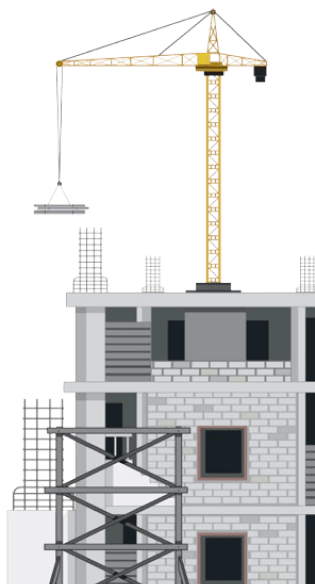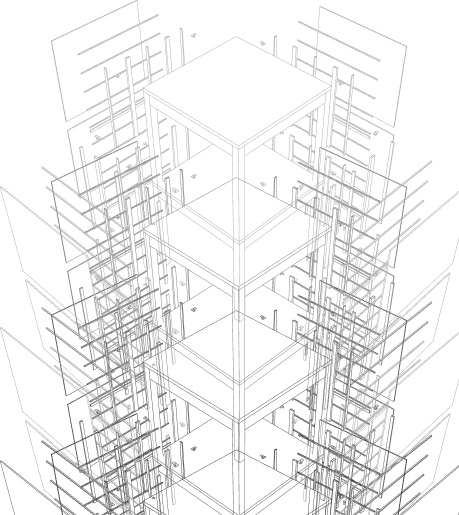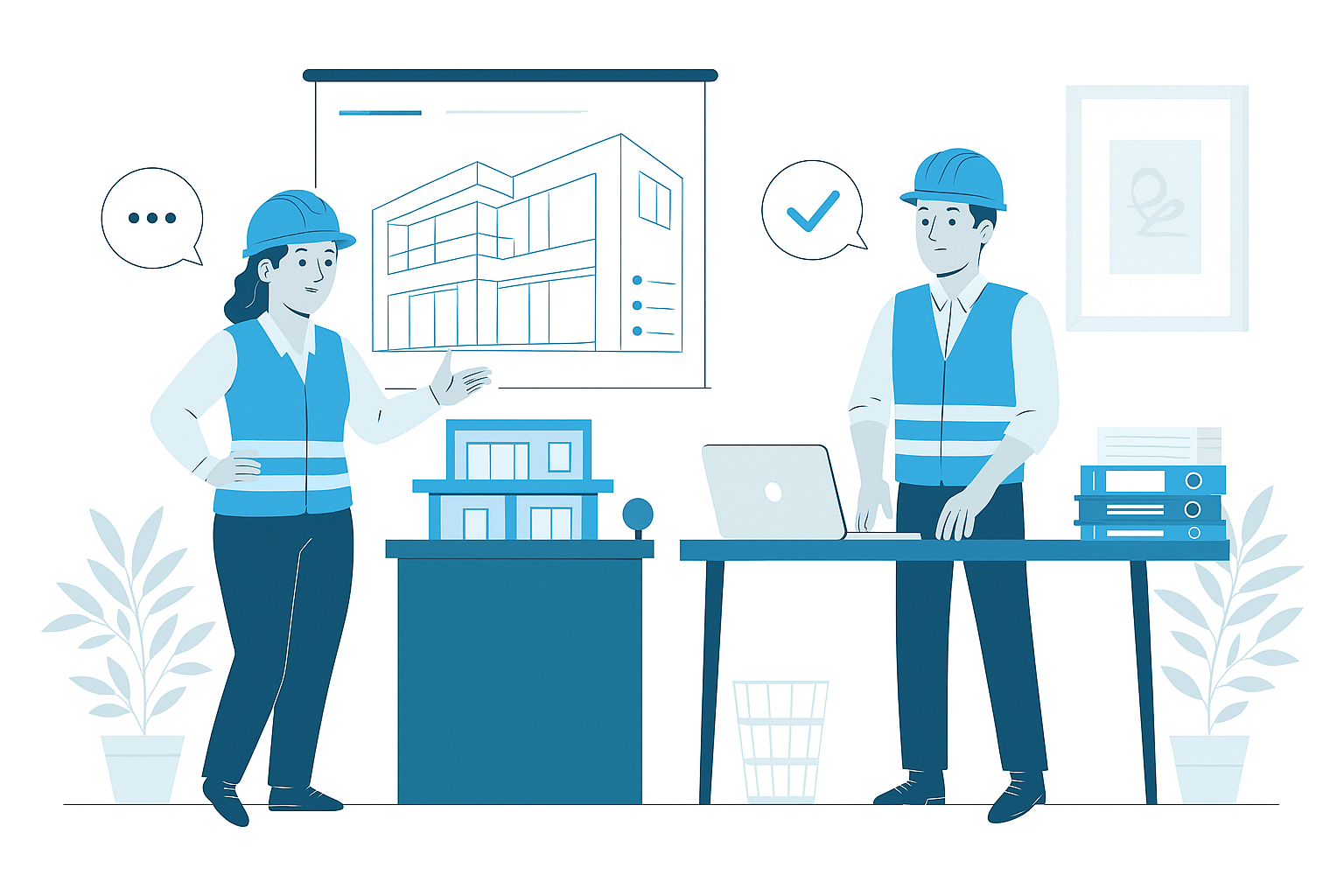Digital Twin Services
In the rapidly evolving world of facility management and operational technology, Digital Twins have emerged as transformative solutions that bridge the gap between physical buildings and digital intelligence. Our specialized Digital Twin services create comprehensive virtual replicas of facilities and assets that combine accurate 3D geometry with real-time operational data from building systems, IoT sensors, and management platforms. These intelligent environments provide unprecedented visibility into building performance, enable proactive maintenance strategies, optimize resource utilization, and transform operational decision-making through continuous monitoring and predictive analytics.

Smart Building Technology
- Comprehensive virtual replicas of buildings with real-time operational data integration
- IoT sensor networks connecting physical building systems to digital environments
- Predictive maintenance capabilities through continuous equipment monitoring
- Energy optimization through performance analysis and operational simulation
- Enhanced decision support with integrated dashboards and management tools
Comprehensive Digital Twin Development
Our Digital Twin services implement a structured approach that creates powerful virtual environments with appropriate operational connections and management capabilities. We begin with detailed facility assessment to understand existing systems, operational priorities, and management objectives that inform solution development. Based on these requirements, we create accurate spatial models through laser scanning, photogrammetry, or BIM adaptation that establish the geometric foundation for the Digital Twin environment. These models are enhanced with smart object definitions, system relationships, and component properties that support operational integration.
The core Digital Twin functionality comes through comprehensive system connections with building automation platforms, IoT sensor networks, equipment monitoring systems, and management applications that provide real-time operational data. These connections are configured with appropriate protocols, refresh rates, and data management to ensure reliable information exchange between physical and digital environments. For user interaction, we develop tailored dashboards, monitoring interfaces, and management tools that transform operational data into actionable intelligence for different stakeholder groups. Throughout implementation, our validation processes ensure data accuracy, system reliability, and user functionality that deliver immediate operational value. The completed Digital Twin provides a comprehensive virtual environment with continuous connection to physical systems, enabling unprecedented operational visibility, enhanced decision support, and transformative management capabilities that significantly improve facility performance throughout its complete lifecycle.
Strategic Benefits of Digital Twins
Implementing comprehensive Digital Twin solutions delivers transformative advantages throughout facility operations, maintenance management, and resource optimization. The immediate benefit comes through enhanced operational visibility, where continuous monitoring provides unprecedented awareness of building conditions, system performance, occupancy patterns, and environmental factors across the entire facility. This comprehensive awareness enables improved decision-making, faster problem resolution, and proactive management that substantially enhance operational outcomes.
For maintenance management, Digital Twins enable revolutionary approaches through continuous equipment monitoring, performance trend analysis, and predictive algorithms that identify potential failures before they occur. This proactive capability typically reduces emergency repairs by 30-50%, extends equipment lifespans by 15-30%, and significantly improves maintenance resource allocation compared to traditional scheduled approaches. Energy optimization benefits from continuous performance monitoring, automated anomaly detection, and operational simulation that collectively improve efficiency by 10-25% while enhancing occupant comfort through better environmental management. Throughout facility operations, these capabilities combine to reduce operational costs by 10-30%, improve space utilization by 15-25%, and substantially enhance both building performance and occupant experience compared to conventional management approaches. By transforming fragmented building data into comprehensive operational intelligence, Digital Twins provide unprecedented management capabilities that deliver significant value throughout the complete operational lifecycle.
Applications of Digital Twins
Corporate & Commercial Facilities
Comprehensive Digital Twin implementation for office buildings, corporate headquarters, and commercial properties with complex operational requirements. Our commercial Digital Twins address space optimization, energy management, maintenance planning, and occupant experience with appropriate monitoring and analytics. These intelligent environments support workplace efficiency, operational cost reduction, and enhanced building performance while providing valuable insights for property management, facility teams, and executive leadership throughout these dynamic commercial environments.
Healthcare & Critical Facilities
Specialized Digital Twin solutions for hospitals, medical centers, data centers, and mission-critical environments with stringent performance requirements and operational priorities. Our critical facility Digital Twins address equipment reliability, environmental control, system redundancy, and maintenance planning with enhanced monitoring and predictive capabilities. These comprehensive solutions support the demanding operational requirements, regulatory compliance, and performance standards necessary for successful management of these essential facilities where system reliability directly impacts organizational outcomes.
Educational & Campus Environments
Integrated Digital Twin environments for university campuses, educational facilities, research buildings, and institutional complexes with diverse operational requirements. Our campus Digital Twins address space utilization, energy management, maintenance coordination, and operational planning across multiple buildings with appropriate system integration and management tools. These comprehensive solutions support both facility efficiency and organizational objectives while providing valuable operational intelligence for administrators, facility managers, and campus planning teams throughout these complex institutional environments.
Industrial & Manufacturing
Specialized Digital Twin implementation for manufacturing facilities, production environments, industrial complexes, and processing plants with complex operational systems and production requirements. Our industrial Digital Twins address equipment performance, production environments, utility systems, and maintenance operations with appropriate monitoring and analytics capabilities. These comprehensive solutions support operational reliability, production efficiency, and resource optimization while providing valuable intelligence for operations teams, maintenance staff, and production management throughout these demanding industrial environments.
Why Choose Us
Advanced Digital Twin Solutions That Transform Facility Operations
01
Expert Team
Certified BIM specialists with extensive experience across architectural, MEP, and facade modeling projects
02
Comprehensive Services
End-to-end BIM solutions from initial modeling to coordination, documentation, and facility management
03
Quality Assurance
Rigorous quality control processes ensuring clash-free models, accurate documentation, and seamless collaboration
04
Dedicated Support
Responsive team available to assist throughout your project lifecycle, ensuring timely solutions and continuous assistance

Know More
Frequently Asked Questions
Digital Twins are comprehensive virtual replicas of physical buildings and infrastructure that combine accurate 3D geometry with real-time operational data, creating dynamic digital environments that mirror the actual performance and condition of facilities. Unlike static BIM models that represent design intent or as-built conditions, Digital Twins maintain continuous connections with physical assets through IoT sensors, building systems, and operational platforms to reflect current conditions, usage patterns, and performance metrics. This integrated approach has become increasingly critical for complex facilities because it bridges the traditional gap between construction documentation and operational management, providing unprecedented visibility into building performance, maintenance requirements, and optimization opportunities. The real-time nature of Digital Twins enables proactive management including predictive maintenance, performance analysis, scenario simulation, and resource optimization that significantly improve operational outcomes. Industry research shows that facilities implementing comprehensive Digital Twin strategies typically experience 10-30% reduced operational costs, 15-25% improved energy efficiency, and substantial enhancements in occupant comfort, equipment reliability, and asset longevity. Beyond these quantifiable benefits, Digital Twins provide enhanced disaster planning, improved emergency response, better capital planning, and more effective space utilization that collectively transform reactive facility management into proactive building optimization throughout the complete operational lifecycle.
Our Digital Twin development process follows a structured methodology that systematically creates comprehensive virtual replicas with appropriate operational connections and data integration. We begin with comprehensive needs assessment, analyzing operational requirements, existing systems, management objectives, and technical infrastructure to establish solution parameters and implementation strategy. Initial modeling develops accurate geometric representation through laser scanning, photogrammetry, or existing BIM transformation to create the spatial foundation for the Digital Twin environment. System integration identifies operational data sources including building automation systems, IoT sensors, maintenance platforms, space management tools, and specialized equipment that will connect with the Digital Twin environment. The platform development configures appropriate Digital Twin software, cloud infrastructure, integration middleware, security protocols, and user interfaces based on operational requirements and organizational capabilities. Data connection establishes bi-directional linkages between physical systems and the virtual environment with appropriate protocols, refresh rates, and validation methods that ensure reliable information exchange. Visualization development creates appropriate dashboards, monitoring interfaces, reporting tools, and interactive displays that transform raw data into actionable intelligence for different user groups. Throughout implementation, progressive testing validates connectivity, data accuracy, system performance, and user functionality to ensure operational reliability. User training programs develop appropriate capabilities for facility managers, maintenance staff, operations teams, and executive stakeholders based on their specific Digital Twin interactions and decision-making requirements. The completed Digital Twin undergoes continuous refinement through feedback cycles, performance evaluation, and capability expansion that ensures long-term value realization. This systematic approach creates comprehensive Digital Twin environments that effectively bridge physical and digital realms regardless of facility complexity, providing powerful operational tools that enhance building performance throughout its complete lifecycle.
Our Digital Twin solutions address diverse facility types across commercial, institutional, industrial, and infrastructure applications with implementation strategies tailored to specific operational requirements and management objectives. For commercial real estate, we develop Digital Twins for office buildings, retail centers, mixed-use developments, and corporate campuses that optimize space utilization, energy performance, tenant experience, and maintenance efficiency. Healthcare facilities including hospitals, medical centers, clinics, and specialized treatment facilities benefit from Digital Twins that monitor critical systems, optimize environmental conditions, support regulatory compliance, and enhance patient experience through integrated operational visibility. Educational environments encompassing university campuses, research facilities, and academic buildings implement Digital Twins to improve space management, energy conservation, maintenance planning, and environmental quality while supporting educational objectives and student experience. For industrial facilities, Digital Twins address manufacturing plants, processing facilities, distribution centers, and production environments with real-time monitoring of equipment performance, production efficiency, environmental conditions, and maintenance requirements. Data centers and critical facilities utilize Digital Twins to ensure operational reliability, optimize environmental systems, manage capacity, and support disaster planning with comprehensive system visibility and performance tracking. Infrastructure applications include transportation facilities, utility systems, public venues, and municipal assets with specialized monitoring of critical components, usage patterns, and maintenance conditions. Each facility type receives tailored Digital Twin implementation based on specific operational priorities, system complexity, and management objectives, creating virtual environments that effectively enhance performance, reduce costs, and improve decision-making regardless of industry context or building type.
Digital Twins deliver transformative operational benefits through comprehensive system visibility, predictive capabilities, and integrated management tools that significantly enhance facility performance and maintenance effectiveness. The primary operational advantage comes through real-time monitoring, where Digital Twins provide immediate visibility into building systems, environmental conditions, occupancy patterns, and equipment status across the entire facility. This comprehensive awareness enables rapid response to operational issues, performance deviations, and environmental concerns before they impact occupants or business functions. For maintenance management, Digital Twins enable condition-based and predictive approaches by continuously analyzing equipment performance data, identifying deterioration patterns, recognizing anomalies, and forecasting potential failures before they occur. This proactive capability typically reduces emergency repairs by 30-50%, extends equipment lifespans by 15-30%, and substantially improves maintenance resource allocation compared to traditional scheduled approaches. Energy optimization benefits from continuous performance monitoring, automated anomaly detection, and scenario simulation that collectively identify efficiency opportunities, verify improvement impacts, and maintain optimal system operation. These capabilities typically reduce energy consumption by 10-25% while improving occupant comfort through better environmental management. Throughout daily operations, Digital Twins provide enhanced decision support through historical trend analysis, performance benchmarking, and operational simulations that improve both tactical responses and strategic planning. By transforming fragmented building data into comprehensive operational intelligence, Digital Twins substantially improve facility performance, reduce operational costs, and enhance building experience for both occupants and management teams throughout the complete operational lifecycle.
Our Digital Twin solutions implement diverse technologies and integrated systems that create comprehensive virtual environments with appropriate operational connections and management capabilities. For spatial representation, we utilize advanced modeling platforms including Autodesk Revit, Bentley Digital Twins, and Siemens Digital Building technologies that create accurate geometric foundations with proper component relationships and system organization. These environments are enhanced through reality capture technologies including laser scanning, photogrammetry, and point cloud processing that ensure accurate representation of existing conditions. Data integration leverages middleware platforms including Azure Digital Twins, AWS IoT TwinMaker, and specialized connectors that establish reliable communication between physical systems and virtual environments. Operational connections incorporate building automation systems (BAS), IoT sensor networks, equipment monitoring platforms, occupant systems, and specialized infrastructure that provide real-time operational data with appropriate protocols and security measures. Analytical capabilities utilize data processing engines, machine learning algorithms, and statistical models that transform raw information into actionable intelligence including anomaly detection, performance prediction, and optimization recommendations. Visualization technologies include interactive dashboards, 3D navigation interfaces, augmented reality applications, and reporting platforms that present operational information in context-appropriate formats for different user groups. Management integration incorporates CMMS systems, space management platforms, energy management tools, and enterprise systems that leverage Digital Twin intelligence for improved operational outcomes. These technology components are implemented through scalable cloud infrastructure with appropriate security protocols, authentication systems, and data management that ensure reliable, secure operation regardless of facility complexity or organizational requirements. Our technology approach emphasizes interoperability, scalability, and accessibility that collectively create powerful Digital Twin environments without proprietary limitations or system constraints, providing long-term operational value throughout the complete building lifecycle.
Our Digital Twin implementations provide powerful sustainability support through comprehensive energy monitoring, performance optimization, and resource management capabilities that significantly enhance environmental performance. The foundation for these benefits is continuous energy monitoring, where Digital Twins track consumption patterns, system performance, and environmental conditions with granular detail across all building systems and zones. This comprehensive visibility reveals inefficiencies, anomalies, and improvement opportunities that frequently remain hidden in traditional building management approaches. For performance optimization, Digital Twins enable advanced strategies including predictive controls, dynamic scheduling, and automated responses that adapt system operation to current conditions, occupancy patterns, and external factors while maintaining comfort and functionality. These capabilities typically reduce energy consumption by 15-25% compared to standard building automation approaches. Carbon reduction benefits from integrated emissions tracking, performance benchmarking, and improvement verification that support sustainability reporting, certification programs, and regulatory compliance with accurate, verifiable documentation. Water conservation leverages flow monitoring, usage analysis, and leak detection that typically reduce consumption by 10-20% while improving system reliability. For renewable energy systems, Digital Twins optimize production utilization, storage management, and grid interaction that maximize clean energy benefits while reducing operational costs. Throughout facility operation, these capabilities support continuous commissioning, performance verification, and system tuning that maintain optimal efficiency despite changing conditions, equipment aging, and operational modifications. By providing comprehensive visibility into sustainability performance with actionable optimization strategies, Digital Twins transform environmental management from periodic assessment to continuous improvement, delivering substantial resource conservation, emissions reduction, and operational savings throughout the complete building lifecycle.
Our Digital Twin solutions deliver transformative space management capabilities through comprehensive utilization monitoring, occupancy analytics, and optimization tools that significantly improve space performance and occupant experience. The foundation for these benefits is real-time occupancy monitoring, where Digital Twins track usage patterns, density levels, and activity distribution across all facility areas using integrated sensors, access systems, and monitoring technologies. This continuous visibility reveals actual utilization patterns, peak demands, and underutilized areas that enable data-driven space planning and allocation. For workplace optimization, Digital Twins support advanced strategies including activity-based planning, neighborhood development, and flexible assignment models that align space configuration with documented work patterns and organizational requirements. These approaches typically improve space efficiency by 20-30% while enhancing employee satisfaction through better environmental alignment. Occupant experience benefits from integrated comfort monitoring, service responsiveness, and environment personalization that collectively improve satisfaction ratings by 15-25% compared to traditional workplace management. Meeting space optimization leverages utilization tracking, reservation analysis, and configuration management that typically improve availability by 30-40% while reducing scheduling conflicts and resource constraints. For retail and public spaces, Digital Twins analyze customer flow, dwell patterns, and interaction points that inform layout optimization, staffing allocation, and service positioning to enhance both operational efficiency and customer experience. Throughout facility lifecycle, these capabilities support scenario planning, renovation analysis, and capacity forecasting that improve capital planning and development strategy. By providing comprehensive visibility into space performance with actionable optimization strategies, Digital Twins transform space management from static allocation to dynamic optimization, delivering substantial efficiency improvements, cost reductions, and experience enhancements throughout the complete building operation.
Our Digital Twin implementations follow structured timelines with progressive value realization that balance immediate operational benefits with long-term transformation objectives. For typical commercial facilities, initial implementation phases spanning 2-4 months establish foundational capabilities including spatial modeling, core system integration, and primary dashboards that deliver immediate visibility into critical operations and high-priority systems. These initial capabilities typically generate 30-40% of total project value through improved awareness, enhanced coordination, and immediate operational insights with minimal disruption to existing processes. Intermediate phases spanning 3-6 additional months develop advanced capabilities including comprehensive system integration, predictive analytics, and specialized management tools that address specific operational priorities and organizational objectives. These expanded capabilities typically deliver an additional 40-50% of project value through enhanced efficiency, improved maintenance, and optimized performance across connected systems. Advanced implementation phases develop specialized capabilities, expand organizational integration, and enhance predictive functions based on accumulated operational data and refined requirements. From an investment perspective, Digital Twin implementations typically deliver positive ROI within 12-24 months through documented operational savings including 10-30% reduced maintenance costs, 15-25% improved energy efficiency, 20-30% enhanced space utilization, and substantial improvements in equipment reliability and lifespan extension. Beyond these quantifiable returns, Digital Twins provide significant value through improved occupant experience, enhanced emergency response, better capital planning, and more effective resource allocation that collectively transform facility management into a strategic organizational advantage. The implementation approach emphasizes modular expansion with value at each stage, ensuring both immediate benefits and sustainable long-term transformation regardless of facility complexity or organizational maturity.
Wide Range of SERVICES
Other Specialized Services
Discover our advanced specialized BIM services addressing unique project requirements and specific industry applications with tailored solutions.
Develop custom Revit families for building components, furniture, equipment, and specialized elements to support detailed BIM modeling.

Extract precise material quantities directly from BIM models to support cost estimation, procurement, and construction planning.

Develop Construction Operations Building Information Exchange (COBie) data sets from BIM models to support facility management and operations.









